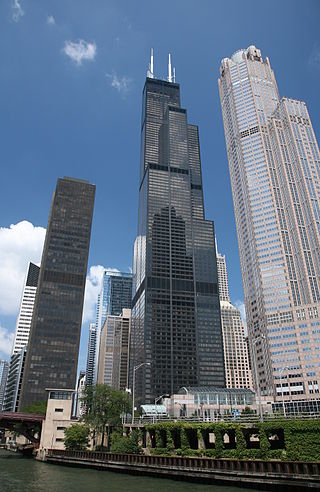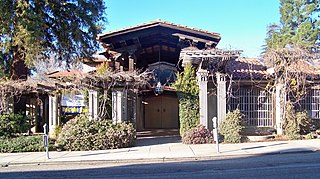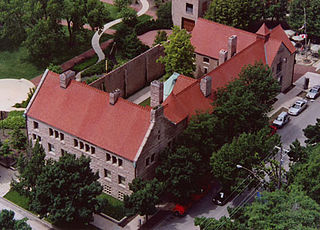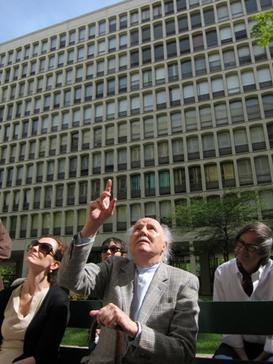
The buildings and architecture of Chicago reflect the city's history and multicultural heritage, featuring prominent buildings in a variety of styles. Most structures downtown were destroyed by the Great Chicago Fire in 1871.

The First Church of Christ, Scientist is the administrative headquarters and mother church of the Church of Christ, Scientist, also known as the Christian Science church. Christian Science was founded in the 19th century in Lynn, Massachusetts, by Mary Baker Eddy with the publication of her book Science and Health (1875).

Solon Spencer Beman was an American architect based in Chicago, Illinois and best known as the architect of the planned Pullman community and adjacent Pullman Company factory complex, as well as Chicago's renowned Fine Arts Building. Several of his other largest commissions, including the Pullman Office Building, Pabst Building, and Grand Central Station in Chicago, have since been demolished. Beman designed numerous Christian Science churches and influenced the design of countless more.

T. B. Blackstone Memorial Library is a building that is part of the Chicago Public Library System and is named after Timothy Blackstone. The building was designed by Chicago architect Solon S. Beman. It is now known as the Chicago Public Library – Blackstone Branch and commonly referred to as Blackstone Library, or Blackstone Branch and sometimes Blackstone for short. The Concord Granite building's two-year construction started in 1902, and it was dedicated on January 8, 1904. Blackstone Library marks the beginning of the Chicago Branch Library System as the first dedicated branch in the system. Blackstone is also the only branch of the 79-branch Chicago Public Library branch system that was constructed using private funding. The Blackstone Library was designated as a Chicago Landmark.

The ten-story Fine Arts Building, formerly known as the Studebaker Building, is located at 410 S Michigan Avenue across from Grant Park in Chicago in the Chicago Landmark Historic Michigan Boulevard District. It was built for the Studebaker company in 1884–1885 by Solon Spencer Beman, and extensively remodeled in 1898, when Beman removed the building's eighth (top) story and added three new stories. Studebaker constructed the building as a carriage sales and service operation with manufacturing on upper floors. The two granite columns at the main entrance, 3 feet 8 inches (1.12 m) in diameter and 12 feet 10 inches (3.91 m) high, were said to be the largest polished monolithic shafts in the country. The interior features Art Nouveau motifs and murals by artists such as Martha Susan Baker, Frederic Clay Bartlett, Oliver Dennett Grover, Frank Xavier Leyendecker, and Bertha Sophia Menzler-Peyton dating from the 1898 renovation. In the early 20th century, the Kalo Shop and Wilro Shop, firms owned by women and specializing in Arts and Crafts items, were established in the renamed Fine Arts Building.

First Church of Christ, Scientist, Berkeley, now also known as Christian Science Society, Berkeley, is a Christian Science church, located at 2619 Dwight Way at Bowditch Street across the street from People's Park, in Berkeley, in Alameda County, California.

The Lackawanna County Children's Library is located in Scranton, Lackawanna County, Pennsylvania, at 520 Vine Street. Built in 1915 as a church, the building is known for its Classical Revival architecture.

The former First Church of Christ, Scientist in Forest Grove, Oregon, United States, is a historic Christian Science church built in 1916. It was designed by Spencer S. Beman, son of the noted designer of Christian Science churches, Solon Spencer Beman who had died in 1914. On January 21, 1994, it was added to the National Register of Historic Places.

The former First Church of Christ, Scientist, built in 1909, is an historic building located at 1813 NW Everett Street, in Portland, Oregon. It was designed by noted Chicago architect Solon Spencer Beman, who designed many Christian Science churches. On October 2, 1978, the building was added to the National Register of Historic Places.
Charles Draper Faulkner was a Chicago-based American architect renowned for the churches and other buildings that he designed in the United States and Japan. He designed over 33 Christian Science church buildings and wrote a book called Christian Science Church Edifices.

The former First Church of Christ, Scientist, located at 2200 Overlook Road, in the University Circle area of Cleveland, Ohio, in the United States is an historic building that was added to the National Register of Historic Places on February 20, 2003.

The First Church of Christ, Scientist is the oldest Christian Science congregation in Toronto, Ontario, Canada. It is located at 196 St. George St. in The Annex neighbourhood, just north of the University of Toronto. It maintains a Reading Room at 927 Yonge Street north of Bloor. The church is a branch of The First Church of Christ, Scientist in Boston, Massachusetts, USA.

The University Child Development Center (UCDC) at the University of Pittsburgh is a child care and early childhood education center located on Clyde Street in Shadyside just east of the main Oakland campus approximately one half mile from the center of campus at the Cathedral of Learning and adjacent to the rear property of the University's Chancellor's Residence on the Oakland-Shadyside border in Pittsburgh, Pennsylvania.

Third Church of Christ, Scientist, established in 1918, is a Christian Science church in downtown Washington, D.C. From 1971 to 2014, the church was located in a controversial building at 16th and I Street NW. Considered a significant work of "Brutalist" church architecture by some critics, the building was considered unsatisfactory by members of the Church's congregation, which shrank over the years. In 2007, the church applied for a demolition permit for the building to permit sale and redevelopment of the site, with plans to relocate to a more suitable structure. A 1991 application for landmark status for the building, filed to forestall a demolition threat then, was subsequently approved. After a lawsuit and hearings, the District of Columbia issued a demolition permit in May 2009, and the building was demolished in 2014. In 2015, Third Church merged with First Church of Christ, Scientist. The congregation continues as First Church and conducts its activities in a portion of the new building.

The former First Church of Christ, Scientist, is an historic Christian Science church building located at 700 22nd Street, Rock Island, Illinois, United States. Designed by architect William C. Jones of Chicago in the Palladian style, it was built between 1914-1915. Its exterior walls are of brick covered by Bedford limestone. Its superimposed front portico is supported by six 2 story columns with egg-and-dart capitals. Its dome actually consists of 2 domes: an outer dome and an inner dome which are separated by a space for lighting fixtures and maintenance. The inner dome consists of some 8,000 colored fish scale glass panes on a wooden support structure. The inner dome is similar to the inner dome of First Church of Christ, Scientist in Kalamazoo, Michigan, which was designed by William C. Jones in 1913.

Prairie Avenue is a north–south street on the South Side of Chicago, which historically extended from 16th Street in the Near South Side to the city's southern limits and beyond. The street has a rich history from its origins as a major trail for horseback riders and carriages. During the last three decades of the 19th century, a six-block section of the street served as the residence of many of Chicago's elite families and an additional four-block section was also known for grand homes. The upper six-block section includes part of the historic Prairie Avenue District, which was declared a Chicago Landmark and added to the National Register of Historic Places.

The former First Church of Christ, Scientist, built in 1907, is an historic Christian Science church edifice located at 1443–1451 North Prospect Avenue in Milwaukee, Wisconsin. It was designed in the Classical Revival style by noted Chicago architect Solon Spencer Beman, who designed at least a dozen other Christian Science churches across the country. On March 8, 1989, it was added to the National Register of Historic Places. Today it is occupied by 1451 Renaissance Place and is the venue for weddings and other social events as well as corporate events.

The Hebrew Tabernacle of Washington Heights is an historic Reform Jewish synagogue located at 551 Fort Washington Avenue, on the corner of 185th Street, in the Washington Heights neighborhood of Manhattan in New York City, New York, U.S. The domed Art Deco style building was built as a church for the Fourth Church of Christ, Scientist, in 1932 and converted to a synagogue in 1973.

Araldo Cossutta was an architect who worked primarily in the United States. He worked at the firm I. M. Pei & Partners from 1956 to 1973. I. M. Pei has been among the most honored architects in the world. Cossutta was Pei's associate and ultimately his partner in the first phase of Pei's career. He was responsible for some of the firm's best-known designs from that era, including three that have received "landmark" designations in recent years. In 1973 he and Vincent Ponte left Pei's firm to form Cossutta & Ponte, which ultimately became Cossutta and Associates. The new firm designed the Credit Lyonnais Tower in Lyon, France (1977) and the Tower at Cityplace (1988) in Dallas, Texas, among other commissions.



















